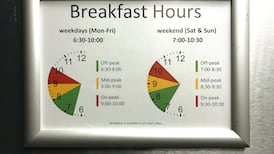Warren Buffet once famously said (in relation to risky finance): “Only when the tide goes out do you discover who’s been swimming naked.” The same can now be said of Dublin city. In an effort to suppress the Covid-19 virus, the economic tide has gone out for many cities around the world, but few cities have been left as nakedly exposed as Dublin or “urban Dublin” to be precise. There is a singular reason for this. Dublin has, for far too long, favoured the temporary, often fleeting visitor over the local urban resident.
A city that prioritises suburban shoppers, daily commuters and the spending power of international tourists over sustainable, mixed-income and family-friendly living at its centre is now – in the era of Covid-19 – reaping the rewards of its anti-urban living policies.
Traffic lights signalling, pavement widths, road widening (and lately National Transport Authority proposed tree felling) all testify to how Dublin has long championed the vehicular movement of its suburbanites over its city’s living pedestrians. The city council obsessively number crunches “shopping pedestrian footfall” in the city centre, whilst failing to generate any meaningful metrics to measure the attractiveness of inner city neighbourhoods.
This is a city that has delivered too few spacious, family-friendly apartment homes at its urban core. In Dublin’s north inner city, an area with a population of 20,000 (the size of Athlone), half of all apartments have just one bedroom, most of these are 38sq m.
More recently it has embraced micro-apartments as a substitute for building quality apartment homes. These 18sqm units with communal living (good luck with that and Covid-19) were laughably described by the then housing minister peddling them as “more like a very trendy, kind of boutique hotel type place”.
Every city needs an appropriate mix of land uses. It is always tricky to strike a balance. Dublin city in recent years has taken a policy punt and a development bet on ever more hotel construction and student accommodation at the expense of building affordable, spacious apartment homes in its urban centre. That now looks like a very bad investment.
Empty rhetoric
For far too long anti-social behaviour has been excused, ignored or misunderstood in Dublin. Economically disadvantaged communities in the heart of the inner city, in particular the very young and the elderly, are most vulnerable to anti-social behaviour. Aggressive begging may have been easier to dismiss or less visible in a bustling city full of tourists and suburban shoppers and office workers, but now it looks a much greater challenge in a forlorn city centre.
It is somewhat ironic that a global pandemic that has afflicted all cities has exposed the local peculiarities of Dublin. Few senior decision makers in Dublin City Council live inside Dublin’s canal ring, even fewer live in apartments. The “paper” ambition to make (urban) Dublin a “great place to live” has always been delivered with lukewarm enthusiasm. At its core were many policy objectives stuffed with unmeasurable platitudes such as “family-friendly living”. Much of that now lies terribly exposed as empty rhetoric.
The urban centres of Amsterdam, Stockholm, Milan, Barcelona and others have their Covid-19 challenges but today they are still busy with locals shopping, dining, moving about, sitting in parks and going about their business.The centre of these cities are populated by a diverse mix of low, middle and high-income families with children.
Covid-19 has even generated some feel-good anecdotal city stories with international news reports of local children happily reclaiming the central urban streets of Barcelona and Rome. Truth be told, despite the very real economic challenges of Covid-19, the centre of many European cities are becoming more liveable not less. This is simply not true of Dublin.
Hollowed out
Yes, other city economies are struggling, shops shuttered, businesses in trouble, but much of Dublin city centre has been hollowed out like few others. With suburban shoppers staying away, middle-income public sector employees working from home in the suburbs, and international tourists gone for the foreseeable future, Dublin city centre is in trouble.
Competitive corporate tax rates may still attract or retain international high-tech companies, but few young tech workers are likely to want to move to, or stay in a hollowed-out and edgier city.
A retreat to low-density suburbia may be a great health defence against Covid-19, but it may kill off any hope of quality living in Dublin city. A dead and edgy Dublin city centre is almost guaranteed to undermine the long-term health of both the Dublin and Irish economy and with that go many of those well-paid jobs of suburban living workers.
What is perhaps most remarkable and depressing about all of this is the near total absence of any discussion or acknowledgement of the unique difficulties facing Dublin. This, perhaps more than anything else, is a sure sign that Dublin is in deep trouble.
Paul Kearns is a former planner with Dublin City Council and the co-author of two books on Dublin planning and urbanism








